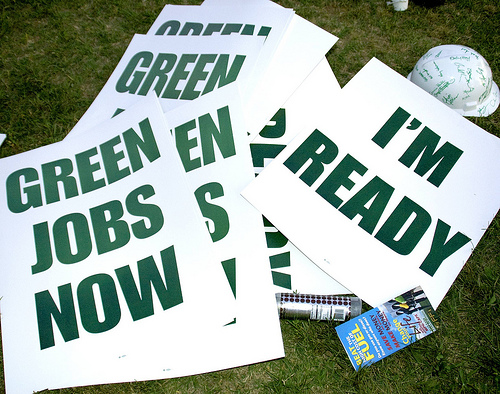If you want to build a sustainable street, neighborhood, city, or world, I have one word for you: plastics.
The facts about plastic have become part of the green liturgy. More than 30 million tons of the stuff is dumped into the municipal waste stream each year in the United States. Disposable water bottles have become the Hummer of plastics — a petroleum-fueled symbol of extravagant waste, a F-You to the planet with some 13 billion of them ending up in landfills, littering landscapes and befouling oceans.
But the reality is that even if you pried every Evian and Dasani bottle from every clammy sweaty hand, we’d still live in a plastic world. It’s a component in just about every product we use, hence the ever-expanding East Pacific Garbage Patch of non-biodegradable, indestructible plastic that will surely move up the food chain and return to us in one form or another.
There’s been no shortage of innovation directed at the dilemma, from the development of biodegradable plant-based plastics to new approaches to recycling and attempts to ban shopping bags and bottles outright.
But perhaps the most promising breakthrough emerged this week from a Silicon Valley lab where IBM and Stanford University scientists have been messing with the molecular composition of the polymers that form plastic. The result: a new kind of plastic that can be made endlessly recyclable or biodegradable.
 IBM scientist Jim Hedrick in the lab at the Almaden Research Center. Photo: NASA Marshall Space Flight Center CollectionWe’ll detour here for a brief science lesson. To create plastic, you need three things — a molecule called a monomer, a solvent, and a catalyst to get the party going. Most plastics are made with metal oxide or hydroxide catalysts.
IBM scientist Jim Hedrick in the lab at the Almaden Research Center. Photo: NASA Marshall Space Flight Center CollectionWe’ll detour here for a brief science lesson. To create plastic, you need three things — a molecule called a monomer, a solvent, and a catalyst to get the party going. Most plastics are made with metal oxide or hydroxide catalysts.
The problem with such catalysts, as IBM’s Chandrasekhar “Spike” Narayan explained to me, is that they sentence plastics to but a single reincarnation. Once you’ve turned plastic bottles into, say, carpet you can’t transform the carpet into T-shirts. (If you really want to all the technical details — and you have a degree in chemistry — you can read the paper Narayan and his collaborators published Tuesday in the journal Macromolecules.)
“These metal oxides are immortal catalysts,” says Narayan, who leads the science and technology team at IBM’s Almaden Research Center in San Jose. That means the metal catalyst continues to contaminate the plastic making it unsuitable for re-use. “But if you have a catalyst that dies,” he adds, “you don’t have that issue.”
And what kind of catalysts die? Organic ones, of course. By substituting organic catalysts for metal oxides, Narayan’s team ended up creating polymers with new properties.
Some plastics can be designed to biodegrade while others can be made so that they can be transformed into entirely new materials in their second lives. For instance, all those discarded water bottles might be reborn as body panels on electric cars or components of an iPad. And when those products reach the end of their useful lives — which could be a matter of months given the planned obsolescence of consumer electronics gadgets — they can be turned into something else.
“It gives you a lot more knobs to turn — a path to polymer architectures that are quite different and that have properties plastics currently don’t have,” enthuses Narayan, who also works on developing smart city technology. “I think it’s going to revolutionize synthetic chemistry.”
Here’s a video from IBM that helps to explain the new plastic breakthrough.
Now, just to be clear, Big Blue’s scientists didn’t set out to save the world when they began their research. Rather they originally sought to develop new polymers to be used in microelectronics.
“IBM Research partners with others to explore applications of that expertise to problems and applications beyond information technology, which is how we began to look at other novel applications” for the polymers, says Sara Delekta Galligan, a company spokeswoman.
So far, this is all still being done inside the lab. But Narayan says IBM is talking to potential partners about commercializing the technology and expects to have a pilot project producing plastic within two years. (And if you think the rest of the world isn’t interested in this technology, consider that the King Abdulaziz City for Science and Technology in Saudi Arabia has already hooked up with IBM to develop recyclable polyethylene terephthalate, PET.)
 The Plastiki. Photo: Todd WoodyA few weeks ago, I had the chance to take a look at another innovative approach to plastic when I went onboard the Plastiki. In a few weeks, British banking heir and environmental adventurer David De Rothschild and his crew will set sail from San Francisco on the catamaran made of plastic and head to Sydney through the Eastern Pacific Garbage Patch, the Texas-size mass of plastic trash that sits in the middle of the ocean.
The Plastiki. Photo: Todd WoodyA few weeks ago, I had the chance to take a look at another innovative approach to plastic when I went onboard the Plastiki. In a few weeks, British banking heir and environmental adventurer David De Rothschild and his crew will set sail from San Francisco on the catamaran made of plastic and head to Sydney through the Eastern Pacific Garbage Patch, the Texas-size mass of plastic trash that sits in the middle of the ocean.
Berthed in Sausalito, Calif., the boat’s hulls are composed of thousands of plastic bottles with the bulk of the boat made from panels of self-reinforcing polyethylene terephthalate that were produced in a process invented by the Plastiki team.
The Plastiki’s mission is to raise awareness of plastic pollution but also to be a floating demo project of how plastic can be repurposed for novel uses, like building a boat. The message: Plastic isn’t going to disappear so the challenge is to how to minimize its production through recycling and reuse.
“We had to look around and innovate,” says De Rothschild,standing on the Plastiki, next to a row of solar panels, a biodiesel-powered emergency motor and the boat’s masts made from old irrigation pipes. “We didn’t want to say plastic is the enemy. The question is, is it our inability to understand the material that’s to blame or is the material that’s to blame?”
Or maybe we’re just the problem. As my Grist colleague David Roberts has pointed out, technological innovation needs to go hand-in-hand with getting people to change their behavior.
For while IBM’s organic plastics and De Rothschild’s approach will help alleviate the poisoning of the planet by plastic, the best plastic bottle is, of course, the one you don’t buy.




